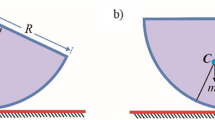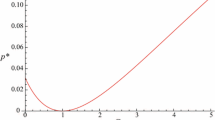Abstract
This paper is concerned with the connection between the Volterra series and the regular perturbation method in nonlinear systems analyses. It is revealed for the first time that, for a forced polynomial nonlinear system, if its derived linear system is a damped dissipative system, the steady response obtained through the regular perturbation method is exactly identical to the response given by the Volterra series. On the other hand, if the derived linear system is an undamped conservative system, then the Volterra series is incapable of modeling the forced polynomial nonlinear system. Numerical examples are further presented to illustrate these points. The results provide a new criterion for quickly judging whether the Volterra series is applicable for modeling a given polynomial nonlinear system.
Similar content being viewed by others
References
Nayfeh, A.H., Balachandran, B.: Applied Nonlinear Dynamics: Analytical, Computational, and Experimental Methods, (2nd edn). Wiley-VCH, Weihheim, Germany (2004)
Pušenjak, R.: Extended Lindstedt-Poincare method for nonstationary resonances of dynamical systems with cubic nonlinearities. Journal of Sound and Vibration 314, 194–216 (2008)
Alijani, F., Amabili, M., Bakhtiari-Nejad, F.: On the accuracy of the multiple scales method for non-linear vibrations of doubly curved shallow shells. International Journal of Non-Linear Mechanics 46, 170–179 (2011)
Alam, M.S.: A modified and compact form of Krylov-Bogoliubov-Mitropolskii unified method for solving an nth order non-linear differential equation. International Journal of Non-linear Mechanics 39, 1343–1357 (2004)
Akbar, M.A., Alam, M.S., Sattar, M.A.: KBM unified method for solving an nth order non-linear differential equation under some special conditions including the case of internal resonance. International Journal of Non-Linear Mechanics 41, 26–42 (2006)
Buonomo, A., Lo Schiavo, A.: Perturbation analysis of nonlinear distortion in analog integrated circuits. IEEE Transactions on Circuits and Systems I: Regular Papers 52, 1620–1631 (2005)
Hamed, Y., Sayed, M., Cao, D., et al.: Nonlinear study of the dynamic behavior of a string-beam coupled system under combined excitations. Acta Mechanica Sinica 27, 1034–1051 (2011)
Nadeem, S., Akbar, N.: Peristaltic flow of Sisko fluid in a uniform inclined tube. ActaMechanica Sinica 26, 675–683 (2010)
Boyd, S., Chua, L.: Fading memory and the problem of approximating nonlinear operators with Volterra series. IEEE Transactions on Circuits and Systems 32, 1150–1161 (1985)
Billings, S.A., Peyton Jones, J.C.: Mapping non-linear integro-differential equations into the frequency domain. International Journal of Control 52, 863–879 (1990)
Peng, Z.K., Lang, Z.Q., Billings, S., et al.: Comparisons between harmonic balance and nonlinear output frequency response function in nonlinear system analysis. Journal of Sound and Vibration 311, 56–73 (2008)
Friston, K.J.: Imaging neuroscience: Principles or maps? Proceedings of the National Academy of Sciences 95, 796–802 (1998)
Korenberg, M.J., Hunter, I.W.: The identification of nonlinear biological systems: Volterra kernel approaches. Annals of Biomedical Engineering 24, 250–268 (1996)
Chen, G., Li, Y.M.: Advances and prospects of the reduced order model for unsteady flow and its application. Advances in Mechanics 41, 686–701 (2011) (in Chinese)
Zhang, Z.J., Xu, M., Chen, S.L., et al.: Investigation of model reduction for aeroservoelasticity based on unsteady aerodynamics estimating. Chinese Journal of Therotical and Applied Mechanics 41, 641–650 (2009) (in Chinese)
Naess, A., Gaidai, O.: The asymptotic behaviour of second-order stochastic Volterra series models of slow drift response. Probabilistic Engineering Mechanics 22, 343–352 (2007)
Worden, K., Tomlinson, G.: Nonlinearity in experimental modal analysis. Philosophical Transactions of the Royal Society of London. Series A: Mathematical, Physical and Engineering Sciences 359, 113–130 (2001)
Chatterjee, A.: Identification and parameter estimation of a bilinear oscillator using Volterra series with harmonic probing. International Journal of Non-linear Mechanics 45, 12–20 (2010)
Jang, T.S., Choi, H.S., Han, S.L.: A new method for detecting non-linear damping and restoring forces in non-linear oscillation systems from transient data. International Journal of Non-linear Mechanics 44, 801–808 (2009)
Vannucci, A., Serena, P., Bononi, A.: The RP method: A new tool for the iterative solution of the nonlinear Schrodinger equation. Journal of Lightwave Technology 20, 1102–1112 (2002)
Ibrahim, R.A., Pandya, A.: Functional-perturbational analysis of non-linear systems under random external and parametric excitations. Journal of Sound and Vibration 137, 443–455 (1990)
Vazquez-Feijoo, J.A., Worden, K., Stanway, R.: On perturbation expansion and the Volterra series. In: Proceedings of 7th International Conference on Recent Advances in Structural Dynamics, Southampton, England (2000)
Lang, Z.Q., Billings, S.A.: Output frequency characteristics of nonlinear systems. International Journal of Control 64, 1049–1067 (1996)
Author information
Authors and Affiliations
Corresponding author
Additional information
The project was supported by the National Science Fund for Distinguished Young Scholars (11125209), and the National Natural Science Foundation of China (51121063 and 10702039).
Rights and permissions
About this article
Cite this article
Dong, XJ., Peng, ZK., Zhang, WM. et al. Connection between Volterra series and perturbation method in nonlinear systems analyses. Acta Mech Sin 30, 600–606 (2014). https://doi.org/10.1007/s10409-014-0010-4
Received:
Revised:
Accepted:
Published:
Issue Date:
DOI: https://doi.org/10.1007/s10409-014-0010-4




